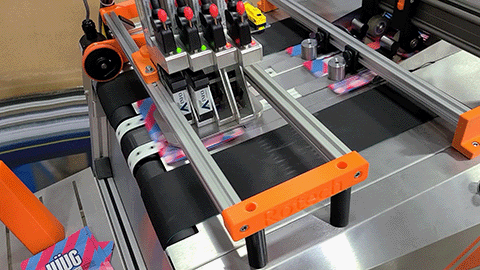Post Date: November 28, 2022
Pouch Growth Aided by Markoprint
The global stand-up pouches market was valued at US$ 10.69 billion in 2019 and expected to reach US$ 18.50 billion by 2027, with a compound annual growth rate (CAGR) of 7.1% during the forecast period 2020 to 2027.
There’s a shift in consumer demand from rigid to flexible packaging, contributing to the significant growth of the global stand-up pouches market. Stand-up pouches are suitable for the packaging of both solid and liquid products, in part because of the packaging trend from heavy to lightweight packaging materials. Stand-up pouches are approximately 4-5 times lighter than metal cans which result in less cost of products along with low packaging weight.
 The food & beverages application segment dominated the global stand-up pouches market in 2019 and is expected to retain its dominance over the forthcoming period. Rising application of stand-up pouches in packaging food products that include breakfast cereals, ready-to-eat meals, gummies, grains, frozen fruit pulp, and frozen fruits & vegetables, among others projected to augment the demand for stand-up pouches over the upcoming period. In addition, the stand-up pouch is also largely used for packaging various beverage products for example energy drinks, flavored juices, coffee, and tea among others.
The food & beverages application segment dominated the global stand-up pouches market in 2019 and is expected to retain its dominance over the forthcoming period. Rising application of stand-up pouches in packaging food products that include breakfast cereals, ready-to-eat meals, gummies, grains, frozen fruit pulp, and frozen fruits & vegetables, among others projected to augment the demand for stand-up pouches over the upcoming period. In addition, the stand-up pouch is also largely used for packaging various beverage products for example energy drinks, flavored juices, coffee, and tea among others.
The personal care & cosmetics application encountered a growth rate of around 7.5% over the analysis period. Commonly packed personal care & cosmetic products that uses stand-up pouches include skincare creams, shampoos, solutions, and many others. The convenience of stand-up pouches during traveling along with increasing awareness related to personal grooming anticipated to boost the market growth for the segment.
With the rise in popularity of bags and pouches come certain challenges for the manufacturer’s packaging operation. Markoprint industrial inkjet is particularly well-suited to print variable codes on flexible packaging prior to filling with product. Flat bags can be stacked in a friction feeder or pick & place feeder in order to code the packaging at very high speeds. Depending on the specifics of the bag, a range of throughput varies from 30 to 100 pieces per minute. A typical payback period for these integrated feeder coding systems is 3 to 12 months depending on how much labor and labels are being displaced.
Running a test of your flat substrates will determine the feedability of the pouch, as well as the ink / substrate compatibility. These print tests are performed free of charge so the packaging company can confirm the viability of the equipment solution. Contact AT INFO by calling (201) 529-0202 X125 or send a message to [email protected].

